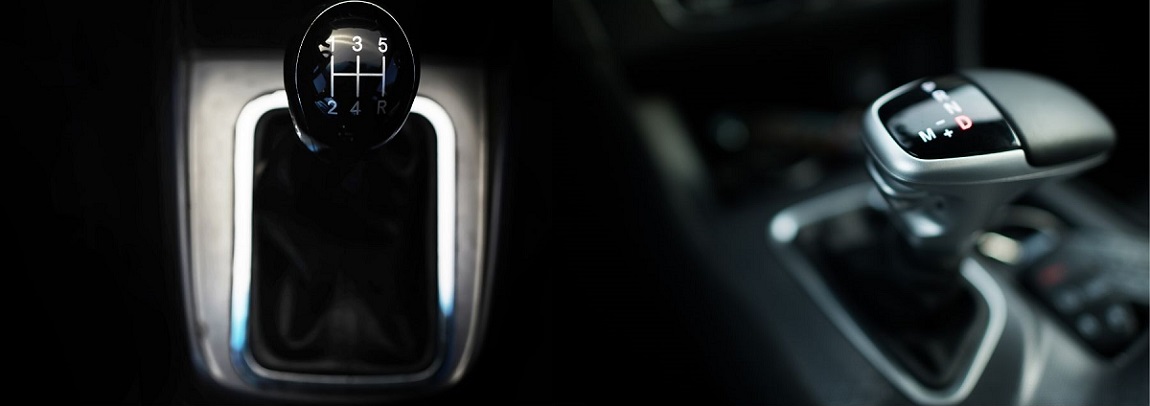
What Transmission is in My Car?
One of the most FAQs among the drivers is, what transmission do I have? A great number of these folks only get to ask this question when they notice that their gear has a problem. Currently, vehicles come with various types of transmissions, while each is having their strengths and weaknesses.
These multiple transmission types might leave you confused. One of the reasons is that their functionality on the surface seems quite similar. However, the reality is that they’re very different. Your vehicle’s transmission is the most complex and least-understood major part of your car or truck. In today’s vehicles, the transmission is a blend of sophisticated hydraulics and chip-controlled components.
Those who have been wondering what transmission is in my car have come to the right address.
What Kind of Transmission Do I Have?
These five are the main types of transmissions in the vehicle.
1. Manual
This is a classic system used in old models, but still popular thanks to its multiple advantages. Manuals are an upgraded variant of a bicycle’s gear shift. You might know them also as thick shifts. In manual trans, you use your foot to operate the clutch and shift the gears. However, manuals have a lot of benefits. Some people feel more secure and in control of the vehicle, which is why you still see many on the road.
They’re harder to learn, but the system is far less complicated than its rivals. Transmission repair aren’t as hard to diagnose or costly to fix. Additionally, manuals have a better fuel economy than automatic transmissions.
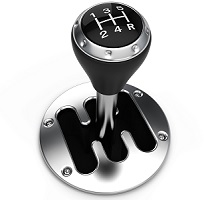

- The vehicle is more engaging for the driver;
- The driver has full control over gears and when to shift;
- It’s usually less expensive than an automatic vehicle;
- The transmission often costs less to repair.

- A manual can get tiresome in heavy traffic;
- It requires precise control on hills to avoid stalling or rolling back;
- It’s harder to find a manual on higher trim levels;
- Only a limited selection of vehicles offers a manual.
2. Automatic
In 2020, this’s the most common transmission you’ll see. An automatic transmission shifts gear electronically as it doesn’t include changing gears manually. All you need to do is speed up or slow down. Also, it has a torque converter, which senses your change of speed. Your vehicle inbuilt computer system will then control an epicyclic gear train set with a set of clutches. A large number of gears provide smoother acceleration. Therefore, driving is a much simpler experience.
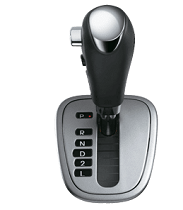

- It’s easier to drive in stop-and-go traffic;
- The majority of vehicles offer an automatic;
- It shifts quicker and smoother;
- It offers better gas mileage;
- A shiftable automatic transmission offers drivers the best of both worlds.

- It’s more expensive to buy than a manual;
- It more moving parts, which leads to greater repair costs;
- Too many gears might shift too often.
3. Semi-Automatic
The combination of the first two, a semi-automatic trans, has a similar design to automatics. But it works under the mechanical set up of two manual transmissions. So, it has a set of inbuilt actuators that adjust the gears for you. You’ll find them to be cheaper than full automatics. Plus, they have a better fuel economy and lower net weight. These advantages come from the manual elements of the transmission.
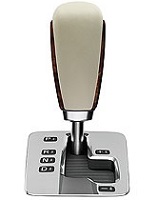

- The driving experience is very smooth when changing gears;
- If the torque converters feel slippage, there won’t be any loss of energy. You won’t experience this during manual shifts, also.

- Requires more money for maintaining than for manual;
- Expensive repairing.
4. Dual Clutch
A dual-clutch transmission (DTC) has an electronic component that operates the manual gear system. So, speed and power ratios are set automatically. Unlike semi-automatics, it features a hydraulic control unit that makes shifting gears easier.
Plus, it has two separate clutches – one for even gears and one for odd. DTC allows you to control the speeds manually. Moreover, you even have the option to stick to the fully automatic mode.
Additionally, dual-clutch systems can be a bit challenging to drive. Anyway, it becomes much more comfortable as you get used to it. The only downside to dual-clutch systems is that the components are susceptible to electronic failures. Also, repairs are expensive and time-consuming.
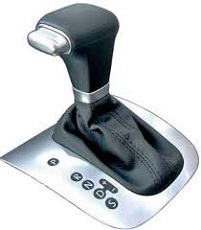

- Quicker acceleration;
- No shift shock and clutch pedal;
- Good fuel economy;
- More driver options;

- Higher vehicle cost;
- Maintenance and repair cost.
5. Continuously Variable Transmission
Continuously variable transmission or CVT is different from a traditional automatic transmission. The standard automatic includes a complex series of gears that deliver the power of the engine to the wheels. Contrarily, The CVT doesn’t have any gears. It has a pair of pulleys of variable width, connected by a belt. One pulley is connected to the engine, the other to the wheels. Since their width is variable, it changes depending on how much power the vehicle needs, hence the term “continuously variable transmission”
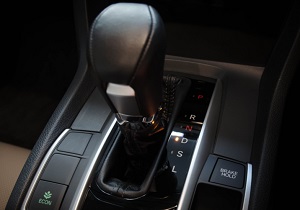

- Outstanding fuel efficiency;
- Optimal power delivery;
- Simpler construction;
- Lighter weight;
- Smooth shifter.

- Noisy operation;
- Expensive maintenance.
How Do I Know What Transmission I Have?
Now you’re ready to start searching which kind of transmission you use. Follow the procedures.
White card on driver’s door
Open the driver’s side door and locate the white card on the side of the door filled with small black lettering. The card contains specific details about the year the vehicle was made, its transmission, engine specs, and other details.
Look under the hood or on the oil pan
Open the hood of the vehicle to identify transmission, since most cars have stickers under the hood with various car specifications. You also can lift the hood and find the transmission oil pan. Some carmakers can be identified by their oil pans as they differentiate the form of the oil pan for various transmissions.
Owner’s manual
A good place to start is to locate your car’s owner manual. The manual may indicate transmission type your vehicle has.
Look under the hood or on the oil pan
Open the hood of the vehicle to identify transmission, since most cars have stickers under the hood with various car specifications. You also can lift the hood and find the transmission oil pan. Some carmakers can be identified by their oil pans as they differentiate the form of the oil pan for various transmissions.
White card on driver’s door
Open the driver’s side door and locate the white card on the side of the door filled with small black lettering. The card contains specific details about the year the vehicle was made, its transmission, engine specs, and other details.
Transmission lookup by VIN
The VIN (vehicle identification number) can be found on either the dashboard or on the driver’s side door. It’ll be on a white sticker with black lettering as a 17-digit code that comprises a combination of numbers and letters. It reveals specific information, such as the car’s year, make, model, country of origin, and assembly plant.
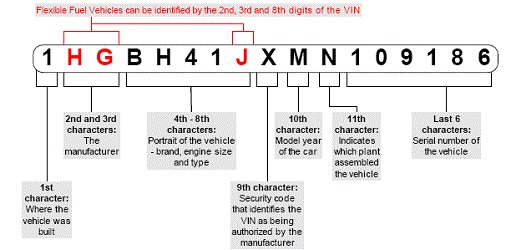
If this table is too complicated for you, take the VIN number to an auto repair shop, where the mechanics should be able to put VIN number into their computer and tell you exactly what transmission you exploit in your vehicle.
What Kind of Automatic Transmission Do I Have?
It may seem that automatics are limited to only automatic gear selection, but many versions are used in almost all kinds of vehicles.
Traditional Automatic Transmission
Also, popular as a torque converter automatic, this widely-used automatic transmission can be found in almost every car. It utilizes a hydraulic fluid coupling or a torque converter shift gears instead of a clutch. The engine control unit (ECU) is directly connected to the mechanism to enable smooth and accurate engine control of the vehicle.
Direct Shift Gearbox (DSG)
Applying a similar setup to a dual-clutch transmission, DSG uses two clutches that disengage alternately in shifting gears. This system offers quick changing and smoother acceleration. Modern platforms also provide fuel efficiency that surpasses manuals. This system is a wet transmission, so expect decades of transmission service as long as the fluid is changed regularly.
Tiptronic Transmission
Usually used in performance or sport-oriented cars, also known as “manumatic,” the tiptronic transmission was released by Porsche in the ’90s. It works similarly to a manual transmission, but it leverages a torque converter in place of a clutch pedal. There’s an option for automatic changing of gears and an opportunity for the driver to override the automatic mode for manual gears.
Sliding-Gear Transmission
Sliding-gear transmissions are only found on older model vehicles. When the gearbox is in neutral, the only things that move within the transmission are the main drive gear and cluster gear. With this kind of transmission, not all of the gears have the same diameters and tooth numbers. The different diameters make the gears rotate at different speeds, and this can create gear clash. This issue is one of the main reasons this model is no longer used.
Constant-Mesh Transmission
Also known as synchronized transmission, the constant-mesh transmission keeps the drive gear, cluster gear, and main shaft gears in constant motion. This’s possible since the gears are free to spin around the main shaft. A dog clutch is utilized to lock these gears into place when they’re needed. When the shift linkage moves, teeth on the main shaft gears and dog clutch lock onto each other and hold the transmission stationary.
Ford Transmission Identification By VIN
| FORD | Years | Engines | Engines |
| B-MAX | 12 | 3 CYL 1.0L 1.4L 1.6L | 6DCT250 |
| C-COUPE | 12 | 1.6L | 6DCT250 |
| C-COUPE | 12 | 2.0L | MPS6(6DCT450) WD CLUTCH |
| C-MAX | 10-12 | 2.0L | MPS6(6DCT450) |
| C-MAX | 12 | 1.6L | 6DCT250 |
| CROWN VICTORIA | 95-11 | 4.6L | 4R75E |
| ECONOLINE 150 | 95-12/97 | 4.9L 5.4L 5.8L | E4OD |
| ECONOLINE 150 | 95-08 | 4.2L 4.6L 5.0L 5.4L | 4R70W |
| ECONOLINE 150 | 04-12 | 4.6L 5.4L | 4R75W |
| SUPER DUTY | 12/97 | V10 6.8L | |
| ECONOLINE 350 | 03-12 | 4.6L 5.4L | 4R75E |
| ECONOLINE 350 | 04-12 | V10 6.8L | 5R110W |
| SUPER DUTY | 12/97 | V10 6.8L | |
| ECONOLINE 350/350 | 1/98-05 | 5.4L 7.3L DIESEL | 4R100 |
| ECOSPORT | 07-12 | 2.0L | 4F27E |
| ECOSPORT | 12 | 1.6L 2.0L | 6DCT250 |
| EDGE | 07-12 | 3.5L 3.7L | 6F50 |
| EDGE | 11-12 | 2.0L | 6F35 |
| ESCAPE | 01-08 | 2.0L 2.3L 3.0L | CD4E |
| ESCAPE | 08-12 | 2.0L 2.3L 2.5L 3.0L | 6F35 |
| ESCAPE HYBRID | 04-06 | 2.3L | P310 |
| ESCAPE HYBRID | 07-11 | 2.3L 2.5L | HD-10 |
| ESCAPE HYBRID | 11-12 | 2.0L | HF35 |
| ESCORT/ZX2 | 90-03 | 1.8L 1.9L 2.0L | F4E |
| EVEREST | 04-11 | 2.5L 3.0L | RE4R01A |
| EVEREST | 04-10 | 3.0L | 5R55S |
| EVEREST | 11 | 3.0L | 6R60 |
| EVEREST | 11-12 | 2.4L 3.2L | 6R80 |
| EXCURSION | 00-05 | 5.4L 7.3L DIESEL V10 6.8L | 4R100 |
| EXCURSION | 03-05 | 5.4L 6.0L DIESEL V10 6.8L | 5R110W |
| EXPEDITION | 12/97 | ||
| EXPEDITION | 97-06 | 4.6L 5.4L | 4R75E |
| EXPEDITION | 07-08 | 5.4L | 6R75 |
| EXPEDITION | 09-12 | 3.5L 5.0L 5.4L | 6R80 |
| EXPLORER | 10-12 | 2.0L | 6F35 |
| EXPLORER | 10-12 | 3.5L | 6F50 |
| EXPLORER/SPORT TRAC | 97-08 | 4.0L | 5R55E |
| EXPLORER/SPORT TRAC | 00-10 | 4.0L 4.6L | 5R55S |
| EXPLORER/SPORT TRAC | 05-10 | 4.6L | 6R60 |
| F-150 /F-250 | 95-10 | 4.2L 4.6L 5.0L 5.4L | 4R75E |
| F-150 /F-250 | 95-97 | 4.9L 5.0L 5.4L 5.8L 7.3L 7.5L | E4OD |
| F-150 /F-250 | 1/98-07 4 SP RWD/4X4 | 5.4L 7.3L DIESEL V10 6.8L | 4R100 |
| F-150 | 08-09 | 4.6L | 6R60 |
| F-150 | 08-12 | 3.5L 3.7L 4.6L 5.0L 5.4L 6.2L | 6R80 |
| F-250 F-350 SD | 03-10 | 5.4L 6.0L 6.4L 6.8L | 5R110W |
| F-250 F-350 SD | 10-12 | 6.2L 6.7L | 6R140 |
| F-450/550 SD | 03-08 | 6.0L DIESEL | 5R110W |
| FIESTA | 00-12 | 1.6L | 80-40LS |
| FIESTA | 08-12 | 1.3L 1.4L 1.5L | 4F27E |
| FIESTA | 10-12 | L31.0L 1.4L 1.6L 2.0L | 6DCT250 |
| FIVE HUNDRED | 05-07 | 3.0L | AF21 |
| FIVE HUNDRED | 05-07 | 3.0L | CFT30 |
| FLEX | 08-12 | 3.5L | 6F50 |
| FOCUS | 00-12 | 1.6L 1.8L 2.0L 2.3L | 4F27E |
| FOCUS | 08-12 | 1.6L 2.0L 2.5L | MPS6 |
| FOCUS | 04-08 | 1.6L 1.8L | CFT23 |
| FOCUS | 00-11 | 1.6L 1.8L 2.0L 2.3L | 4F27E |
| FOCUS | 10-12 | 1.6L 1.8L 2.0L | 6DCT250 |
| FOCUS | 04-08 | 1.6L 1.8L | CFT23 |
| FREESTAR | 04-07 | 3.9L 4.2L | 4F50N |
| FREESTYLE | 05-07 | 3.0L | CFT30 |
| FUSION | 06-11 | 1.6L | 80-40LS |
| FUSION | 06-08 | 2.3L | FNR5 |
| FUSION | 06-09 | 3.0L | AF21 |
| FUSION | 09-12 | 2.0L 2.5L 3.0L | 6F35 |
| FUSION | 09-12 | 3.5L | 6F50 |
| FUSION | 10-11 | L31.0L 1.4L 1.6L | 6DCT250 |
| FUSION | 09-12 | 2.5L | HD-10 |
| MUSTANG | 05-10 | 4.0L 4.6L | 5R55S |
| MUSTANG | 10-12 | 3.7L 5.0L | 6R80 |
| PRONTO | 00-07 | L31.0L | TW-40E |
| RANGER | 00-06 | 2.5L | JR400E |
| RANGER | 00-07 | 2.5L | RE4R01A |
| RANGER | 97-11 | 2.3L 3.0L 4.0L | 5R55E |
| RANGER | 00-09 | 2.5L 3.0L | 5R55S |
| RANGER | 01-12 | 2.3L 3.0L | 5R44E |
| RANGER | 10-12 | 2.2L 2.5L 3.0L 3.2L | 6R80 |
| TAURUS | 01-07 | 3.0L | 4F50N |
| TAURUS | 04-07 | 3.0L | AF21 |
| TAURUS | 07-12 | 3.5L | 6F50 |
| TAURUS | 04-07 | 3.0L | CFT30 |
| TERRITORY SX | 04-05 | 4.0L | DSI M93LE |
| TERRITORY SY | 05-11 | 4.0L | DSI M93LE |
| TERRITORY SY | 05-12 | 4.0L | ZF6HP26 |
| THUNDERBIRD | 03-05 | 3.9L | 5R55S |
| TIERRA | 00-07 | 1.6L | 4F27E |
| TRANSIT CONNECT | 09-12 | 2.0L | 4F27E |
Chevy Transmission Identification By VIN
| CHEVY | Years | Engines | Engines |
| ACADIA | 07-12 | 3.6L | 6T75 |
| ASTRA | 04-11 | 2.0L | AW50-40LE |
| ASTRO | 95-05 | 4.3L | 4L60E |
| AVALANCHE | 01-08 | 5.3L 8.1L | 4L60E |
| AVALANCHE | 06-08 | 6.0L | 4L70E |
| AVALANCHE | 08-12 | 5.3L 6.0L | 6L80 |
| AVEO | 04-10 | 1.6L | ZF4HP14 |
| AVEO | 05-08 | 1.4L 1.6L | AW60-41SN |
| AVEO | 06-12 | 1.4L | 80-40LS /81-40LE U440 |
| AVEO | 07-12 | 1.5L 1.6L | AW60-40LE |
| AVEO | 09-12 | 1.4L 1.6L | 6T30 |
| B-CUV | 12 | 1.8L | 6T30 |
| BLAZER | 95-05 | 2.2L 2.3L 3.0L 4.3L 5.3L | 4L60E |
| CAMARO | 09-12 | 3.6L | 6L50 |
| CAMARO SS | 09-12 | 6.2L | 6L80 |
| CANYON | 03-12 | 2.8L 2.9L 3.5L 3.7L 5.3L | 4L60E |
| CAPTIVA/SPORT | 08-10 | 2.4L | 4T45E |
| CAPTIVA | 06-12 | 2.0L 2.4L 3.2L | AW55-50SN |
| CAPTIVA/SPORT | 07-12 | 2.0L 2.4L 3.0L 3.2L | 6T40 /6T45 |
| CAPTIVA/SPORT | 08-12 | 2.2L 3.6L | 6T70 |
| CASSIA | 00-02 | 1.6L | AW60-41SN |
| CAVALIER | 95-05 | 2.2L 2.3L 2.4L | 4T40E |
| COBALT | 05-10 | 2.2L 2.4L | 4T45E |
| COLORADO | 03-12 | 2.8L 2.9L 3.5L 3.7L 3.6L 5.3L | 4L60E |
| COLORADO | 04-12 | 2.4L 2.8L 3.0L | JR405E |
| CORVETTE | 95-05 | 5.7L 6.0L | 4L60E /4L65E |
| CORVETTE | 05-12 | 6.0L 6.2L | 6L80 |
| CRUZE | 01-05 | 1.5L | AW60-40LE |
| CRUZE | 01-08 | 1.3L | 81-40LS |
| CRUZE | 09-12 | 1.6L 1.8L 2.0L | 6T30 |
| CRUZE | 09-12 | 1.4L 1.6L 1.8L 2.5L | 6T40 /6T45 |
| ENVOY | 99-09 | 4.2L 5.3L | 4L60E |
| EQUINOX | 04-09 | 3.4L | AF33-5 |
| EQUINOX | 07-12 | 3.0L 3.6L | 6T70 |
| EQUINOX | 09-12 | 2.4L | 6T40 /6T45 |
| EQUINOX | 11-12 | 3.6L | AHS-F |
Dodge Transmission Identification By VIN
| DODGE | Years | Engines | Engines |
| AVENGER | 08-12 | 2.4L 2.7L | 41TE |
| AVENGER | 08-12 | 2.4L 2.7L 3.5L 3.6L | 62TE |
| CALIBER | 06-12 | 2.0L 2.4L | JF011E |
| CARAVAN/GRAND CARAVAN | 07-12 | 2.8L 3.3L 3.6L 3.8L 4.0L | 62TE |
| CHALLENGER | 08-11 | 3.5L | 42RLE |
| CHALLENGER | 08-12 | 5.7L 6.1L | W5A580 |
| CHALLENGER | 12 | 6.4L | ZF8HP45 |
| CHARGER | 05-10 | 2.7L 3.5L | 42RLE |
| CHARGER | 05-12 | 3.5L 3.6L 5.7L 6.1L 6.4L | W5A580 |
| CHARGER | 12 | 3.6L | ZF8HP45 |
| DURANGO | 04-08 | 42RLE | |
| DURANGO | 02-12 | 4.7L 5.7L | 545RFE |
| DURANGO | 10-12 | W5A580 | |
| DURANGO HYBRID | 09 | 5.7L HEMI | AHS-T |
| JOURNEY | 08-10 | 2.4L 2.7L | 41TE |
| JOURNEY | 09-12 | 2.0L 2.2L | MPS6(6DCT450) WD CLUTCH |
| JOURNEY | 09-12 | 2.7L 3.5L 3.6L | 62TE |
| MAGNUM | 04-08 | 2.7L | 42RLE |
| MAGNUM | 04-08 | 3.5L 5.7L 6.1L | W5A580 |
| NEON | 01-06 | .2.0L | 41TE |
| NITRO | 07-11 | 42RLE | |
| NITRO | 07-11 | 2.8L 4.0L | W5A580 |
| PICKUP/DAKOTA | 03-11 | 3.7L | 42RLE |
| PICKUP/DAKOTA | 01-11 | 4.7L | 545RFE |
| PICKUP/RAM 1500 | 02-05 | 3.7L 4.7L | 45RFE |
| PICKUP/RAM 1500-3500 | 02-12 | 3.7L 4.7L 5.7L | 545RFE |
| PICKUP/RAM 2500-3500 | 03-07 | V10 8.0L 5.9L DIESEL 6.7L DIESEL 48RE | |
| PICKUP/RAM 2500-3500 | 06-12 | 5.9L 6.7L DIESEL | 68RFE |
| PICKUP/RAM 3500 | 07-12 | 6.7L DIESEL | A45X |
| RAM 3500 / 4500 / 5500 CHASSIS CAB | 03-14 | 6.7L DIESEL | AS68RC / AS69RC |
| SPRINTER | 03-10 | 2.7L 3.5L | W5A330 |
| SPRINTER | 07-10 | 3.0L | W5J400 |
| STRATUS | 01-05 | 2.4L SOHC | F4A42-2 |
| STRATUS | 01-05 | 3.0L | F4A51-2 |
| VAN/WAGON 1500-2500 | 95-03 | 3.9L | 32RH |
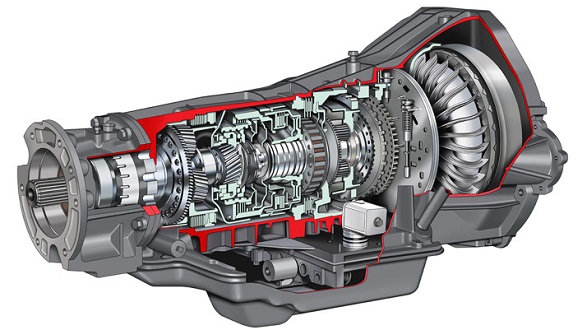
Honda Transmission Identification Numbers
| HONDA | Year | Transmission | Code | Engine |
|---|---|---|---|---|
| A-BOX | 2013 – 2013 | CVT FWD | SS-CVT | L3 0.7L |
| ACCORD | 2010 – 2012 | 5 SP FWD | P79A | V6 3.5L |
| ACCORD | 2013 – 2013 | EVT FWD | MM5E | L4 2.0L |
| ACCORD | 2003 – 2007 | 5 SP FWD | BCLA | L4 2.4L |
| ACCORD | 2003 – 2007 | 5 SP FWD | BAYA,MAYA | V6 3.0L |
| ACCORD | 2008 – 2012 | 5 SP FWD | B97A | V6 3.5L |
| ACCORD | 2000 – 2011 | 5 SP FWD | MCTA | L4 2.0L 2.4L |
| ACCORD | 2012 – 2013 | EVT FWD | LL-CVT | L4 2.4L |
| ACCORD | 2013 – 2017 | 6 SP FWD | BB7A | V6 3.5L |
| ACCORD | 2008 – 2012 | 5 SP FWD | B90A | L4 2.0L 2.4L |
| ACCORD | 2008 – 2012 | 5 SP FWD | M91A | L4 2.4L |
| ACCORD | 2012 – 2017 | CVT FWD | BC5A | L4 2.4L |
| ACCORD | 2003 – 2007 | 5 SP FWD | MCLA | L4 2.4L |
| ACCORD HYBRID | 2005 – 2007 | 5 SP FWD | MURA | V6 3.0L |
| B-CUV | 2013 – 2013 | 7 SP FWD | SM-DCT | L4 1.5L |
| BRIO/BRIO AMAZE | 2012 – 2017 | CVT FWD | SM-DCT | L4 1.2L |
| C-NPV | 2013 – 2013 | CVT FWD | LL-CVT | L4 2.4L |
| CITY | 2008 – 2012 | 5 SP FWD | MRMA | L4 1.5L |
| CITY | 2001 – 2012 | CVT FWD | SWRA (CVT) | L4 1.3L 1.5L |
| CITY | 2007 – 2011 | 4 SP FWD | BMXA | L4 1.3L 1.5L |
| CITY | 2000 – 2012 | CVT FWD | SLYA (CVT) | L4 1.3L 1.5L |
| CITY | 2012 – 2013 | 5 SP FWD | BRZA, MZ2A | L4 1.8L |
| CIVIC | 2012 – 2013 | CVT FWD | SM-CVT | L4 1.5L |
| CIVIC | 2014 – 2017 | CVT FWD | M3WC | L4 1.8L |
| CIVIC | 2014 – 2017 | 9 SP FWD | ZF9HP48 | L4 1.6L |
| CIVIC | 2013 – 2013 | CVT FWD | LL-CVT | L4 1.8L |
| CIVIC (EXC. HX) | 2001 – 2005 | 4 SP FWD | BMXA,SLXA | L4 1.7L |
| CIVIC HX/GX | 2002 – 2005 | CVT FWD | SLYA (CVT) | L4 1.7L |
| CIVIC HYBRID | 2003 – 2005 | CVT FWD | SZCA | L4 1.3L |
| CIVIC HYBRID | 2006 – 2012 | CVT FWD | SPSA | L4 1.3L |
| CIVIC HYBRID | 2006 – 2012 | CVT FWD | SMLA | L4 1.7L |
| CIVIC/DX/EX/LX/GX | 2006 – 2010 | 5 SP FWD | SPCA, MPCA | L4 1.8L |
| CR-V | 2012 – 2017 | 9 SP FWD | ZF9HP48 | L4 1.6L |
| CR-V | 2005 – 2006 | 5 SP AWD | MKZA, GPPA | L4 2.4L |
| CR-V | 2008 – 2010 | 5 SP AWD | BZHA | L4 2.4L |
| CR-V | 2012 – 2013 | CVT FWD | M-CVT | L4 2.0L |
| CR-V | 2007 – 2010 | 5 SP AWD | MZHA | L4 2.4L |
| CR-V | 2008 – 2010 | 5 SP FWD | BZJA | L4 2.4L |
| CR-V | 2005 – 2006 | 5 SP FWD | MKYA, GPLA | L4 2.4L |
| CR-V | 2012 – 2014 | 5 SP FWD/AWD | B5RA, B5SA | L4 2.4L |
| CR-V | 2007 – 2012 | 5 SP FWD | MZJA | L4 2.4L |
| CR-Z | 2011 – 2013 | CVT FWD | STYA | L4 1.5L |
| CROSSROAD | 2007 – 2011 | 5 SP FWD/AWD | BZHA | L4 1.8L 2.0L |
| CROSSTOUR | 2010 – 2011 | 5 SP AWD | BBTA | V6 3.5L |
| CROSSTOUR | 2013 – 2015 | 6 SP FWD/AWD | BZ0A, BY9A | V6 3.5L |
| CROSSTOUR | 2012 – 2012 | 5 SP FWD/AWD | P9ZA, P9YA | V6 3.5L |
| CROSSTOUR | 2010 – 2011 | 5 SP FWD | BBSA | V6 3.5L |
| CROSSTOUR | 2012 – 2013 | 5 SP FWD | BJ1A | L4 2.4L |
| ELEMENT | 2008 – 2010 | 5 SP AWD | BZNA | L4 2.4L |
| ELEMENT | 2003 – 2007 | 4 SP AWD | MZKA | L4 2.4L |
| ELEMENT | 2003 – 2006 | 4 SP FWD | BZKA | L4 2.4L |
| ELEMENT | 2007 – 2011 | 5 SP FWD | MNZA | L4 2.4L |
| ELEMENT | 2007 – 2010 | 4 SP AWD | MZKA | L4 2.4L |
| ELEMENT | 2008 – 2010 | 5 SP FWD | BZKA | L4 2.4L |
| FIT | 2009 – 2010 | 5 SP FWD | SP5A ,MP5A | L4 1.5L |
| FIT | 2009 – 2012 | CVT FWD | M4VA | L4 1.3L |
| FIT | 2003 – 2008 | CVT FWD | SZCA | L4 1.3L |
| FIT | 2007 – 2008 | 5 SP FWD | SMMA | L4 1.5L |
| FIT/FIT ARIA | 2002 – 2011 | CVT FWD | SLYA (CVT) | L4 1.5L |
| FREED | 2008 – 2017 | CVT FWD/AWD | RE5 (CVT) | L4 1.5L |
| HR-V | 2000 – 2005 | CVT FWD/AWD | SETA (CVT) | L4 1.6L |
| INSIGHT | 2010 – 2015 | CVT FWD | SBLA | L4 1.3L |
| INSIGHT | 2001 – 2006 | CVT FWD | MHTA | L3 1.0L |
| JAZZ | 2003 – 2008 | CVT FWD | SLYA (CVT) | L4 1.5L |
| JAZZ | 2008 – 2012 | 4 SP FWD | BMXA | L4 1.5L |
| JAZZ | 2002 – 2008 | CVT FWD | SWRA (CVT) | L4 1.3L |
| MOBILIO | 2001 – 2008 | CVT FWD/AWD | SWRA (CVT) | L4 1.5L |
| ODYSSEY | 2013 – 2016 | 6 SP FWD | PYRA | V6 3.5L |
| ODYSSEY | 2011 – 2013 | 5 SP FWD | PV1A | V6 3.5L |
| ODYSSEY | 2007 – 2007 | 5 SP FWD | B36A | V6 3.5L |
| ODYSSEY | 2011 – 2011 | 6 SP FWD | MV2A | V6 3.5L |
| ODYSSEY | 2016 – 2017 | 9 SP FWD | ZF9HP48 | V6 3.5L |
| ODYSSEY | 2012 – 2012 | 6 SP FWD | BYKA | V6 3.5L |
| ODYSSEY | 2011 – 2012 | 6 SP | PV2A | |
| ODYSSEY | 2009 – 2012 | 5 SP FWD | P36A | V6 3.5L |
| ODYSSEY | 2005 – 2007 | 5 SP FWD | BGRA ,PGRA | V6 3.5L |
| PILOT | 2009 – 2012 | 5 SP AWD | PN3A | V6 3.5L |
| PILOT | 2008 – 2008 | 5 SP AWD | P34A | V6 3.5L |
| PILOT | 2003 – 2007 | 5 SP AWD | BVGA,PVGA | V6 3.5L |
| PILOT | 2009 – 2012 | 5 SP FWD | PN4A | V6 3.5L |
| PILOT | 2008 – 2008 | 5 SP FWD | P35A | V6 3.5L |
| PILOT | 2003 – 2007 | 5 SP FWD | BVLA.PVLA | V6 3.5L |
| PILOT | 2015 – 2017 | 9 SP FWD/AWD | ZF9HP48 | V6 3.0L 3.5L |
| RIDGELINE | 2006 – 2008 | 5 SP AWD | BJFA, MJFA | V6 3.5L |
| RIDGELINE | 2009 – 2014 | 5 SP AWD | PSFA | V6 3.5L |
| SPIRIOR | 2009 – 2011 | 5 SP FWD | B90A | L4 2.0L 2.4L |
| STREAM | 2002 – 2006 | 4 SP FWD/AWD | BMXA | L4 1.7L |
| STREAM | 2002 – 2014 | 5 SP FWD/AWD | MRMA | L4 1.8L 2.0L |
